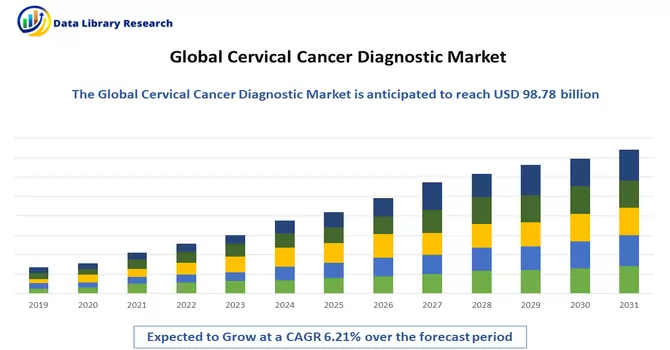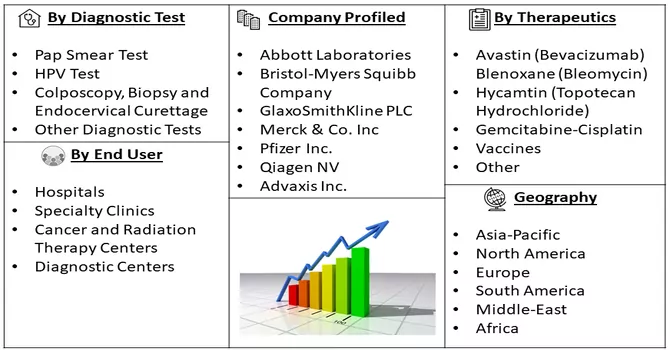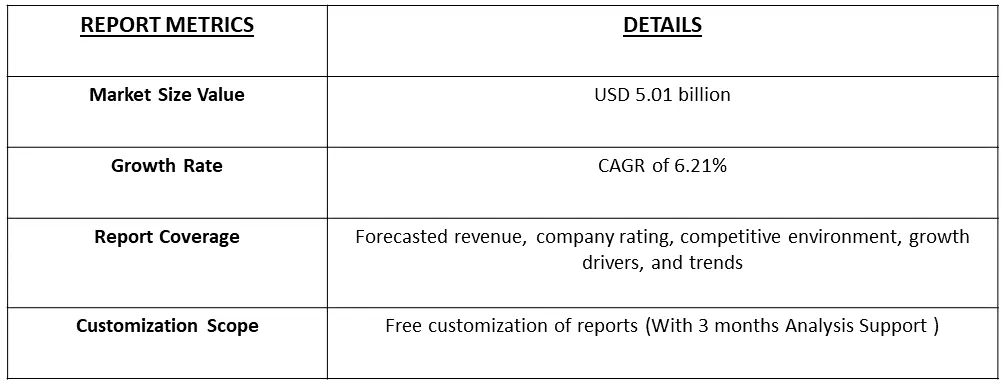The projected growth of the Global Cervical Cancer Diagnostics and Therapeutics Market indicates an increase from USD 98.78 billion in 2022 and is anticipated to occur at a Compound Annual Growth Rate (CAGR) of 6.21% over the forecast period spanning from 2023 to 2030.

Get Complete Analysis Of The Report - Download Free Sample PDF
The sector dedicated to cervical cancer diagnostics and therapeutics encompasses a spectrum of activities related to the identification, diagnosis, and treatment of cervical cancer. Cervical cancer, a form of cancer originating in the narrow lower part of the uterus known as the cervix, prompts the deployment of various products, services, and technologies aimed at preventing, detecting, and managing the disease.
The introduction and widespread adoption of HPV vaccines have played a crucial role in preventing cervical cancer by reducing the incidence of HPV infections, a precursor to cervical cancer. Public health initiatives advocating for regular Pap smears, HPV testing, and other screening methods contribute to early detection, thereby enhancing treatment outcomes.
There is a growing focus on utilizing HPV vaccination as a primary preventive measure to decrease the occurrence of cervical cancer. Additionally, there is an ongoing expansion of vaccination initiatives in diverse regions, with a concerted effort to enhance vaccine coverage among eligible populations. The persistent advancement and uptake of molecular testing methods play a crucial role in achieving more precise and early identification of cervical abnormalities. Furthermore, there is active exploration and progress in the realm of liquid biopsy techniques, offering less invasive and more convenient diagnostic options.
Market Segmentation: The Cervical Cancer Diagnostics and Therapeutics Market has been segmented by Diagnostic Test (Pap Smear Test, HPV Test, Colposcopy, Biopsy and Endocervical Curettage, and Other Diagnostic Tests), Therapeutics (Avastin (Bevacizumab) Blenoxane (Bleomycin), Hycamtin (Topotecan Hydrochloride), Gemcitabine-Cisplatin, Vaccines, Other Therapeutics ), End User, ( Hospitals, Specilty Clinics, Cancer and Radiation Therapy Centers, Diagnostic Centers), and Geography (North America, Europe, Asia-Pacific, Middle-East and Africa, and South America). The report offers value in USD million for the above segments.

For Detailed Market Segmentation - Download Free Sample PDF
Market Drivers:
Growing Awareness About HPV Vaccination Programs:
The extensive adoption and effectiveness of HPV vaccination initiatives play a pivotal role in propelling advancements within the cervical cancer diagnostics and therapeutics industry. Human Papillomavirus (HPV) stands out as a primary contributor to cervical cancer, and the successful vaccination against high-risk HPV types has demonstrated efficacy in preventing the development of cervical lesions that may progress to cancer. The increasing embrace of HPV vaccination as a key strategy for primary prevention contributes significantly to diminishing the overall incidence of cervical cancer. Consequently, this shift in focus from late-stage treatment to early prevention and detection influences the demand dynamics for diagnostics and therapeutics in the industry.
Advancements in Diagnostics Technologies
The ongoing progress in diagnostic technologies plays a pivotal role in propelling the cervical cancer diagnostics and therapeutics market. Enhanced diagnostic tools, including molecular testing, liquid biopsies, and the incorporation of artificial intelligence (AI) applications in imaging, significantly improve the accuracy and efficiency of cervical cancer detection. Molecular testing facilitates the identification of specific genetic markers linked to cervical cancer, while liquid biopsies provide less invasive methods for sample collection. The integration of AI into diagnostic imaging aids in interpreting complex data, leading to more precise and timely identification of abnormalities. These technological advancements contribute to early diagnosis, facilitating prompt intervention and personalized treatment strategies, thereby fostering demand for relevant diagnostic and therapeutic products in the market.
Market Restraints:
Limited Access to Healthcare Services and High Cost of Advanced Therapeutics
The limited access to healthcare services, particularly in low- and middle-income countries, poses a challenge to the effective implementation of cervical cancer diagnostics and therapeutics. Challenges such as inadequate infrastructure, a shortage of healthcare professionals, and financial constraints in certain regions may impede women's access to regular screenings, timely diagnosis, and appropriate treatment. Insufficient awareness and education about cervical cancer in some communities contribute to delayed healthcare-seeking behavior. This global disparity in healthcare access presents a significant obstacle to addressing cervical cancer comprehensively and has the potential to impact the overall market growth. The high cost of advanced therapeutic options for cervical cancer poses a substantial constraint in certain healthcare systems, limiting the adoption of cutting-edge treatments, such as targeted therapies and immunotherapies, and potentially creating disparities in treatment availability, thereby affecting overall market expansion and patient outcomes in economically constrained regions. Thus, the above-mentioned factors are expected to slow down the growth of the studied market over the forecast period
The healthcare systems worldwide faced interruptions in routine screenings and preventive care services as the focus shifted to managing the COVID-19 pandemic. Lockdowns, restrictions, and apprehensions about virus transmission contributed to a decline in the number of women seeking regular cervical cancer screenings. The pandemic led to delayed diagnoses across various medical conditions, including cervical cancer, as patients hesitated to visit healthcare facilities and non-urgent medical appointments were frequently postponed. This postponement in diagnosis has the potential to result in the identification of more advanced stages of cervical cancer when eventually detected.
Segmental Analysis:
Pap Smear Test Segment is Expected to Witness Significant growth Over the Forecast Period
The primary purpose of a Pap smear is to detect abnormal changes in the cells of the cervix, which may indicate the presence of cervical cancer or pre-cancerous conditions. Early detection allows for timely intervention and preventive measures. During a Pap smear, a healthcare provider collects a small sample of cells from the cervix using a spatula or brush. The collected cells are then transferred to a glass slide or placed in a liquid medium for laboratory analysis. In the laboratory, the collected cells are examined under a microscope to identify any abnormalities, such as changes in cell size, shape, or structure. Abnormalities may suggest the presence of precancerous or cancerous cells. Thus, owing to the above-mentioned factors the segment is expected to witness significant growth over the forecast period.
Avastin (Bevacizumab) Segment is Expected to Witness Significant growth Over the Forecast Period
Avastin, or bevacizumab, is a monoclonal antibody targeting vascular endothelial growth factor (VEGF) and is utilized in treating various cancers, including cervical cancer. Its mechanism involves inhibiting VEGF, a protein crucial for angiogenesis, the formation of new blood vessels. Avastin disrupts tumor blood supply, hindering growth and potentially preventing cancer spread by blocking VEGF. Approved for use alongside chemotherapy, especially in cases of persistent, recurrent, or metastatic cervical cancer, Avastin is typically combined with other chemotherapeutic agents. Clinical trials have evidenced that adding Avastin to standard chemotherapy regimens enhances progression-free survival in advanced cervical cancer patients, studied in both first-line and recurrent cervical cancer scenarios. Thus, pwing to the above-mentioned factors, the segment is expected to witness significant growth over the forecast period.
North America Region is Expected to Witness Significant growth Over the Forecast Period
North America, particularly the United States and Canada, has a well-established and advanced healthcare infrastructure. This facilitates access to state-of-the-art diagnostic technologies, treatment modalities, and a comprehensive healthcare system.
Also, the region has implemented organized cervical cancer screening programs, emphasizing the importance of regular Pap smears, HPV testing, and other screening methods. These programs aim to detect abnormalities early and provide timely interventions. The region has actively promoted HPV vaccination as a preventive measure against cervical cancer. Efforts to increase vaccination rates among eligible populations contribute to long-term cervical cancer prevention.
Furthermore, favorable government policies in the United States are anticipated to propel the overall market in the forecast period. Recent updates from the Centers for Disease Control and Prevention as of February 2022 highlight the impact of the National Breast and Cervical Cancer Early Detection Program (NBCCEDP) on fostering market growth across the United States. Moreover, January has been officially designated as "Cervical Health Awareness Month" by the United States Congress. During this month, the National Cervical Cancer Coalition (NCCC) and its local chapters conduct awareness campaigns addressing cervical cancer, HPV disease, and the significance of early detection. Simultaneously, the market receives support from continuous product launches by key players. For example, in September 2021, the US FDA granted accelerated approval to tisotumab vedotin-tftv, a tissue factor-directed antibody and microtubule inhibitor conjugate, designed for adult patients experiencing recurrent or metastatic cervical cancer with disease progression after or during chemotherapy. Thus, the above-mentioned factors are expected to drive the growth of the studied market in the region.

Get Complete Analysis Of The Report - Download Free Sample PDF
The Cervical Cancer Diagnostics and Therapeutics Market is fragmented, competitive, and consists of several major players. In terms of market share, a few of the major players are currently dominating the market. Companies are currently focusing on developing advanced techniques for diagnosis, such as liquid-based cytology. Some of the companies currently dominating the market are:
Recent Developments:
1) In September 2022, the Drugs Controller General of India (DCGI) issued market authorization to the Serum Institute of India (SII) for the production of a domestically developed vaccine targeting cervical cancer.
2) In June 2022, Karkinos Healthcare, a health-tech platform with a focus on oncology, introduced CerviRaksha, a groundbreaking HPV test that has received prequalification from the World Health Organization and approval from the Food and Drug Administration. This innovative test was launched in collaboration with doctors and nurses affiliated with the Karkinos network hospital.
Q1. What was the Cervical Cancer Diagnostic Market size in 2022?
As per Data Library Research Cervical Cancer Diagnostics and Therapeutics Market indicates an increase from USD 98.78 billion in 2022.
Q2. What is the Growth Rate of the Cervical Cancer Diagnostic Market?
Cervical Cancer Diagnostic Market is expected to grow at a Compound Annual Growth Rate (CAGR) of 6.21% over the forecast period.
Q3. Which Region is expected to hold the highest Market share?
North America region is expected to hold the highest Market share.
Q4. What are the factors driving the Cervical Cancer Diagnostic Market?
Key factors that are driving the growth include the Growing Awareness About HPV Vaccination Programs and Advancements in Diagnostics Technologies
Data Library Research are conducted by industry experts who offer insight on industry structure, market segmentations technology assessment and competitive landscape (CL), and penetration, as well as on emerging trends. Their analysis is based on primary interviews (~ 80%) and secondary research (~ 20%) as well as years of professional expertise in their respective industries. Adding to this, by analysing historical trends and current market positions, our analysts predict where the market will be headed for the next five years. Furthermore, the varying trends of segment & categories geographically presented are also studied and the estimated based on the primary & secondary research.
In this particular report from the supply side Data Library Research has conducted primary surveys (interviews) with the key level executives (VP, CEO’s, Marketing Director, Business Development Manager and SOFT) of the companies that active & prominent as well as the midsized organization
FIGURE 1: DLR RESEARH PROCESS

Extensive primary research was conducted to gain a deeper insight of the market and industry performance. The analysis is based on both primary and secondary research as well as years of professional expertise in the respective industries.
In addition to analysing current and historical trends, our analysts predict where the market is headed over the next five years.
It varies by segment for these categories geographically presented in the list of market tables. Speaking about this particular report we have conducted primary surveys (interviews) with the key level executives (VP, CEO’s, Marketing Director, Business Development Manager and many more) of the major players active in the market.
Secondary ResearchSecondary research was mainly used to collect and identify information useful for the extensive, technical, market-oriented, and Friend’s study of the Global Extra Neutral Alcohol. It was also used to obtain key information about major players, market classification and segmentation according to the industry trends, geographical markets, and developments related to the market and technology perspectives. For this study, analysts have gathered information from various credible sources, such as annual reports, sec filings, journals, white papers, SOFT presentations, and company web sites.
Market Size EstimationBoth, top-down and bottom-up approaches were used to estimate and validate the size of the Global market and to estimate the size of various other dependent submarkets in the overall Extra Neutral Alcohol. The key players in the market were identified through secondary research and their market contributions in the respective geographies were determined through primary and secondary research.
Forecast Model
